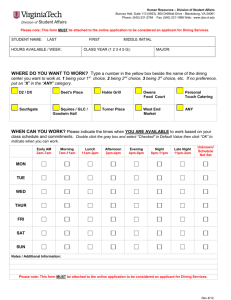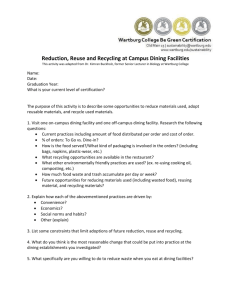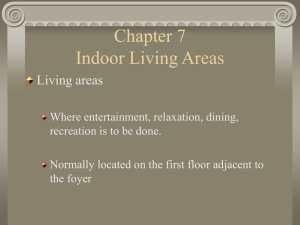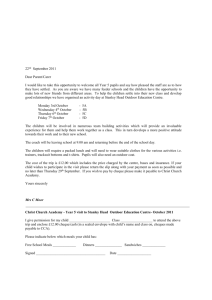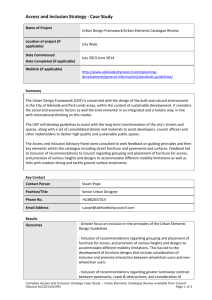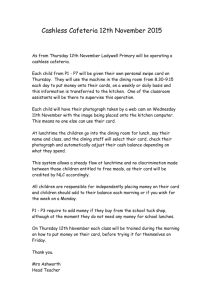Accessible Word template
advertisement
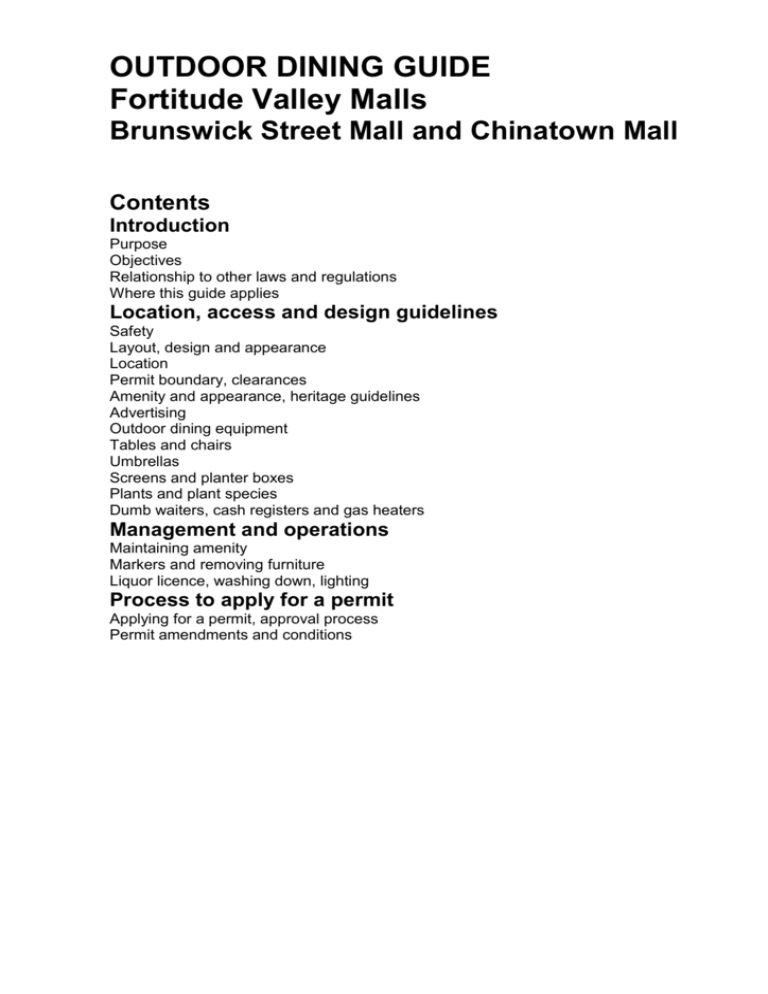
OUTDOOR DINING GUIDE Fortitude Valley Malls Brunswick Street Mall and Chinatown Mall Contents Introduction Purpose Objectives Relationship to other laws and regulations Where this guide applies Location, access and design guidelines Safety Layout, design and appearance Location Permit boundary, clearances Amenity and appearance, heritage guidelines Advertising Outdoor dining equipment Tables and chairs Umbrellas Screens and planter boxes Plants and plant species Dumb waiters, cash registers and gas heaters Management and operations Maintaining amenity Markers and removing furniture Liquor licence, washing down, lighting Process to apply for a permit Applying for a permit, approval process Permit amendments and conditions Introduction Purpose Brisbane City Council is committed to developing the Valley Malls precinct into a world-class entertainment destination that is clean, safe, well-maintained and supports a 24-hour economy. The rejuvenation of Brunswick Street Mall, completed in July 2014, highlights Council’s commitment to boosting the Valley economy through improving amenities and creating an enhanced public space. Council supports outdoor dining within the Valley Malls, as it encourages increased social and cultural life, and contributes to the precinct’s identity, animation and security. The information in this booklet is intended as a guide for businesses operating outdoor dining facilities in the Valley Malls. If you have questions about any of the information in this guide, please contact the City Malls Management team on (07) 3403 8195. Objectives This guide provides simple procedures and guidelines to ensure a quality alfresco dining offering within the Valley Malls. The guide will: • • • inform and advise the owner or operator of a food business who occupies, or proposes to occupy, part of the Valley Malls for the purposes of outdoor dining outline best-practice design guidelines and requirements for establishing and managing outdoor dining in the Valley Malls help ensure the Valley Malls precinct is a clean, safe, well-maintained and vibrant entertainment destination. Relationship to other laws and regulations Specific legislative requirements need to be met for outdoor dining. The following acts take precedence over Council policy and must be considered in conjunction with this guide: • • • • Food Act 2006 Electrical Safety Regulation 2002 Building Fire Safety Regulation 2008 other related Brisbane City Council local laws. Where this guide applies This guide applies to all land within the Valley Malls, as illustrated below in red. Location, access and design guidelines Council has developed guidelines for the location and design of an outdoor dining area. These guidelines will help to improve the usage, quality and image of the Valley Malls. Businesses that wish to use an area of the Valley Malls for outdoor dining will need to apply for a Permit to Occupy. This includes businesses such as cafes, take-away food stores, bars and restaurants with tables and chairs on the mall. Before issuing a permit, Council will consider other competing uses of the mall space, in order to establish a practical balance among various user groups. Note: Permit to Occupy is the legal definition of the informal term outdoor dining permit. Safety, layout design and appearance Safety Businesses operating under an outdoor dining permit need to contribute both to the vibrancy of the mall, and to the safety and security of patrons and pedestrians. The placement and location of outdoor dining needs to consider the safety and flow of pedestrian traffic, particularly at times when there are very high volumes of pedestrians. Permit holders need to ensure their outdoor dining areas: • • • • • • are located in areas that are considered safe for patrons and pedestrians do not compromise wheelchair access to premises meet special requirements for lines of sight to adjacent premises and for CitySafe closed circuit television (CCTV) cameras do not compromise the safety of pedestrians in adjoining buildings by restricting access and breaching fire safety regulations do not conflict with other uses within the mall do not obstruct pedestrian flow through the mall. For outdoor dining areas to be approved, applicants will need to meet the above requirements. Council will assess each proposed outdoor dining location individually. If a location is deemed unsuitable for this activity, approval may not be granted. Layout, design and appearance The layout, design and appearance of outdoor dining items should: • • • • contribute to the mall’s character and sense of place relate appropriately to heritage places meet circulation and safety requirements make the adjoining premises attractive and welcoming. The choice and placement of outdoor dining items must consider other elements such as existing or future public furniture, trees, light poles and adjoining buildings. Outdoor dining items must be contemporary in design, materials, finishes and colours and must be of a high standard in appearance, cleanliness, durability and comfort. Tip: White tables, chairs and umbrellas are discouraged due to their tendency to quickly deteriorate and discolour. Location Outdoor dining spaces should allow good access to public street furniture such as seats, bicycle parking, drinking fountains, rubbish bins, telephone booths, infrastructure, ramps and building entrances. A permit for outdoor dining will not be granted where its location, size or layout may compromise public access, circulation, safety or other street activities. Generally, an outdoor dining area must be located directly outside the associated business premises and within the area defined by the marker disks on either side of the premises’ boundaries. Note: Permits allow Council to conduct events as required including weekend markets. Permit boundary, clearances Permit boundary Extending outdoor dining into areas not directly outside the associated business is generally not permitted. For example, a business will not normally be allowed to operate outdoor dining outside the frontage of another business. Clearances A minimum clearance of 2 metres is required through outdoor dining areas at each point where there is an entry to or exit from premises abutting the mall. This ensures unrestricted access to and exits from buildings, and complies with fire safety regulations. If an electrical switchboard is located in the outdoor permit area, a minimum clearance of 1.5 metres is required at all times around the access door to the electrical switchboard. Clearance requirements are illustrated in diagram 1 below. Diagram 1: Entrance to cafe tenancy requires a minimum 2 metre clearance through dining area as indicated by the arrow to the centre of the mall. Note: Clearance areas must not be used to store tables, chairs, planter boxes, displays or other items. Amenity and appearance, heritage guidelines Amenity and appearance Outdoor dining areas need to protect and enhance the urban heritage and character of the Valley Malls. Some general guidelines to ensure this are listed below. • • • • • • Trees should not be obstructed, covered, removed, relocated or modified as a result of an outdoor dining area installation and operation. Umbrellas and awnings may be permissible. If the tree canopies are extensive, umbrellas should be kept to a minimum. Where appropriate, screens can be used to provide protection from wind and separate outdoor dining areas from pedestrian traffic areas. The style of outdoor dining items should fit with the design of adjacent building frontages and the surrounding streetscape. Outdoor dining furniture should be high-quality, comfortable, durable and an appropriate style. The above principles may form enforceable conditions of any permit approval. The business owner or operator is responsible for ensuring the outdoor dining area is regularly cleaned and maintained to a high standard. Note: Any breach of a permit condition may constitute an offence, and ongoing noncompliance may also result in the cancellation of the permit. Heritage guidelines The design and location of outdoor dining areas adjacent to a heritage building should be compatible with the heritage significance of the building. Advertising Advertisements are subject to Council approval and conditions. Signage to identify the business name or logo is permitted on canvas screens and umbrellas. One free-standing sign such as an A-frame, a removable sign or a sandwich board is only permissible within the outdoor dining permit area. Note: No third party advertising is allowed on any outdoor dining item, for example any advertising unrelated to the business. Outdoor dining equipment Outdoor dining equipment The placement of outdoor dining equipment such as tables, chairs, screens, signs, umbrellas, planter boxes and other equipment, requires Council’s approval, and cannot occur until an appropriate permit has been issued. Outdoor dining equipment must: • • • • • • be positioned within the permitted boundaries be kept clean, tidy and in good condition at all times be positioned to allow reasonable access for clearances and ease of movement for patrons and staff be readily removed and stored within the associated indoor premises when the business is not trading be safe and not a potential hazard for users (i.e. no sharp edges, hinges or other moving parts) fold or stack for easy storage. Tables and chairs Tables and chairs should be stylish, functional and durable and be placed in a way to create a welldesigned and inviting dining environment. Tables and chairs should: • • • • be easy to clean be light-weight and stackable to allow easy handling meet appropriate safety standards ensure the comfort of patrons (metal surfaces, with the exception of aluminium, do not insulate well and can feel cold or become uncomfortably hot if exposed to the sun). It is important to consider exposure to weather when selecting outdoor dining items, particularly seating material and covers. Note: The use of cheap, fully extruded, or moulded plastic chairs and tables are not permitted as they do not withstand prolonged and intensive use, are prone to cracking and discolouring and feature sharp seams and edges. Note: Round tables are more appropriate than square as they can accommodate a flexible amount of chairs. Umbrellas, screens and planter boxes Umbrellas Removable umbrellas may be used to provide shade and shelter to patrons and to promote the outdoor dining operation. The following principles apply to removable umbrellas. • • • • A minimum clearance of 2.3 metres is required from the edge of the umbrella to the mall’s surface. Umbrella canopies need to be a neutral colour and made of a high-quality material, such as canvas. Artistically designed canopies may be considered on a case-by-base basis. Umbrellas are only allowed where existing shelter such as canopies or trees are inadequate. Umbrellas must be advertisement free, but may contain a business logo. Umbrella bases: • • must be properly monitored and weighted with appropriate base plates (28 kilogram minimum), to prevent them blowing over in strong winds must not be raised by more than 0.1 metres or represent a trip hazard to pedestrians. The following must be observed when locating umbrellas. • • Umbrella canopy edges are to be set back a minimum of 0.6 metres from any vehicle traffic areas to avoid conflict with moving traffic. Umbrella canopies may extend a maximum of 0.3 metres beyond the outdoor dining area boundary facing the mall. These requirements are detailed in diagram 2 below. Applicants must include details of the proposed umbrellas with their permit application. Note: Plastic canopies are not permitted. Diagram 2: Requirements for removable umbrellas. Screens Screens may be used to separate an outdoor dining area. Screens should: • • • • • • • be free-standing and removable, and have a light-weight frame or be fixed to the mall surface if approved by Council be easily installed and de-mounted be weighted down during periods of use not exceed 0.9 metres in height be a single colour be suitably located within the available space be compatible with the design of adjacent building frontages and mall streetscape. Planter boxes Planter boxes may be used to further define an outdoor dining area and bring variety and colour to the mall. Planter boxes should: • • • • • • • • • be made of high-quality and durable materials able to withstand harsh treatment complement the streetscape and character of the mall be strong enough to meet their functional requirements be resilient against vandalism and pedestrian impact be located along the perimeter of the outdoor dining area be located appropriately to allow pedestrians to move freely allow a 1 metre clearance from existing infrastructure be placed with a minimum gap of 0.3 metres between them be elevated above the pavement to allow for drainage. When planter boxes are used in groups to define an outdoor dining area they are considered enclosures. In these circumstances, a 1.5 metre space is required every 5 metres and between adjoining outdoor dining areas with planters. The permit holder must regularly maintain and clean planter boxes and plants to ensure they remain visually attractive. These requirements are detailed in diagram 3 below. Diagram 3: Requirements for planter boxes. Note: Plastic planter boxes are not permitted. Note: When cleaning planter boxes no run-off should go into the stormwater system, stain pavements, or cause a safety hazard for pedestrians. Plants and plant species Plants When applying for an outdoor dining permit, applicants should include details of proposed plants to be included within the area. Plants should: • • • be regularly pruned so they do not affect use within and around the outdoor dining area be placed directly into the planter boxes be placed close together to avoid large voids which may attract littering. Failure to keep plants and planter boxes well maintained will result in the permit holder being directed to remove them. Plant species Council has supplied a list of guiding principles to use when selecting plant species for an outdoor dining area. • • • • Use evergreen plants for full vegetative cover. Select dense-cover plant varieties that are not dominated by stems or light foliage, to ensure cover all year round. Plant slow-growing plants that do not need regular pruning and maintenance. Plant drought-tolerant and hardy plant species to minimise maintenance. Permit holders should avoid plants species that: • • • have messy flowers or fruit that drop have prickles that may cause injury or discomfort to patrons produce high levels of pollen or are toxic. Note: Plants must remain in their planter boxes after trading hours. Empty planter boxes are unsightly and may attract littering and undesirable behaviour. Recommended plant species The below lists contains plant species that are suitable for planter boxes in an outdoor dining area. Plants for sun include: • • • • • • • • • dwarf nandina (Nandina domestica) silver streak (Dianella ensata) evergreen giant (Liriope cultivar) liriope just right (Liriope muscari) stripey white (Liriope cultivar) liriope el marco (Liriope muscari) mondo grass (Ophiopogon japonicas) dwarf bottlebrush (Callistemon cultivar) variegated dwarf umbrella (Schefflera arboricola). Plants for shade include: • • • • • • zanzibar gem (Zamioculcas zamiifolia) cast iron plant (Aspidistra elatior) power petite madonna lily (Spathiphyllum cultivar) parlour palm (Chamaedorea elegans) xanadu (Philodendron cultivar) rattlesnake plant (Calathea insignis). Dumb waiters, cash registers and gas heaters Dumb waiters Dumb waiters must: • • • • • be no larger than 1.2 metres wide, 1 metre high and 0.6 metres deep be made of materials that match the chairs and tables be sited centrally within the outdoor dining permit area blend visually into the outdoor dining area be used only for crockery, cutlery, menus, napkins and similar items, and not as a means to serve or hold food. Cash registers Cash registers may be allowed within an outdoor dining area. Details of how the cash register and power supply will be safely installed and maintained must be submitted with the permit application. Gas heaters Gas heaters may be temporarily located within an outdoor dining area to provide additional comfort for patrons, and must: • • • • be industry-approved, high-quality gas heaters that meet Australian standards and occupational health and safety requirements be self-contained and free-standing be securely fixed and stable not be placed where they may pose a safety or fire hazard. Installation and operation of gas heaters should be in accordance with AS 4565-2001 (AG 405) Radiant Gas Heaters. Note: Information on proposed dumb waiters, cash registers and gas heaters must be provided to Council when applying for an outdoor dining permit. Management and operations Management and operations Managing outdoor dining areas in the Valley Malls The business owner or operator must take full responsibility for their outdoor dining area and its effect on adjoining businesses and the mall as a whole. Good hygiene is essential and tables must be cleared and cleaned as soon as patrons have left. This includes cleaning up any litter, putting chairs back in place and preparing the area for the next guests. Along with friendly and efficient service, quality food and drink, good hygiene and clean premises are key to ensuring a high-quality offering. Maintaining amenity Council may restrict outdoor dining operations where there is a potential or actual negative impact on the amenity of the area or a history of complaints. Council can condition, modify or revoke an outdoor dining permit at its discretion. Maintaining amenity, maintenance and cleaning Maintenance and cleaning Permit holders are required to apply high standards of cleaning and maintenance, and comply with the health standards and conditions of the permit at all times. Permit holders are responsible for ensuring these requirements are met. • • • • • Tables and chairs must be arranged as per the agreed layout proposed in the permit application. Furniture, including plants and planter boxes, must be kept in a safe and well-maintained condition at all times. The outdoor dining area must be regularly cleaned during all hours of operation. This includes cleaning furniture and equipment, and regularly sweeping and mopping the pavement and adjacent areas of the mall. No waste material or sweepings are to be disposed of into the mall, stormwater grates or public bins. Wind-proof ashtrays, or another means to capture ash and butt litter, is required where smoking is allowed within a designated smoking area. Markers and removing furniture Markers An outdoor dining area must be contained within its approved boundaries. These boundaries will be shown by Council’s pavement marker discs. Normally, the corners of the outdoor dining area are marked by circular marker discs set flush with the pavement. All furniture, equipment and signage must remain inside the approved boundaries. Note: This is a marker disc for outdoor dining. Removing furniture An outdoor dining area must be vacated at the end of trade on a daily basis. All outdoor dining equipment including tables, chairs, umbrellas, planter boxes, screens and gas heaters must be removed from the mall at the end of trade daily. As per the permit conditions, an outdoor dining area may be required for other activities such as weekend markets or Council works. Businesses will be given advance notification of such activity. The requirement to remove outdoor dining equipment is based on the following. • • • • • • Outdoor dining areas revert to open public space after the private use has ceased. Outdoor dining operations limit other uses within the mall such as markets and mall events. Outdoor dining creates clutter on the mall. Outdoor dining may become an obstacle for people with a vision impairment. Items left outside can deteriorate rapidly, collect dirt and may be vandalised or stolen. Items left outside become an obstacle for programmed cleaning and maintenance. Liquor licence, washing down, lighting Liquor licence Permit holders are required to advise Council if they are applying for a liquor licence. An application for the consumption of alcohol at an outdoor dining area must be made initially to the Queensland Government’s Office of Liquor and Gaming Regulation. Once a licence has been granted, alcohol can only be served and consumed within the designated area. Washing down Permit holders are required to dry sweep, collect and dispose of solid waste as much as possible, prior to mopping the pavement. Where a more intensive clean is required, permit holders may engage an external contractor. Prior to doing so, they must obtain approval from Council. Note: Do not hose down or discharge waste water, or washdown water, into the stormwater system. Lighting To ensure safety and amenity for patrons and pedestrians, permit holders are responsible for providing adequate lighting where outdoor dining occurs outside daylight hours. • • • Lighting requirements additional to those already on the mall are subject to Council approval. Details of additional external lighting (including specifications) must be provided to Council. No free-standing lighting will be permitted. All lighting must be vandal-resistant, glare-free, and designed to the relevant Australian standards. Note: All external electrical works are to be undertaken by a licensed electrician. Evidence must be supplied showing the installation complies with the Electrical Safety Act. Process to apply for a permit Applying for a permit To obtain an outdoor dining permit, an application form must be completed and submitted to Council. Outdoor dining applications will only be considered for an existing or proposed business whose core function is to provide a sit-down service of food and beverages for the public. Note: Applications for sale of take-away food from within permit areas will not be approved. Businesses who wish to submit an application for an outdoor dining permit can access the form by: • • • visiting www.brisbane.qld.gov.au and searching ‘outdoor dining in malls’ visiting the City Malls Management Office at Level 1/277 Brunswick Street, Fortitude Valley phoning Council’s Contact Centre on (07) 3403 8888. Completing an application requires an understanding of this guide, relevant legislation and related Council policies and local laws. These requirements can be explained at a pre-application meeting with a City Malls officer. Businesses can request a pre-application meeting by emailing malls.management@brisbane.qld.gov.au or phoning (07) 3403 8195. Processing applications To help Council assess an application, the following supporting documents need to be submitted with the completed application form. • • At least one copy of a plan outlining the proposed outdoor dining area. This plan must identify pedestrian traffic circulation (drawn to scale). Colour photographs or brochures detailing specifications of the furniture, accessories and fittings to be placed on the mall. • • • • Photographs or drawings of the advertising to be placed on any structures or equipment. Details of any external lighting proposed, showing the types of fixtures and their proposed placement. Public liability insurance Certificate of Currency for $20 million. One or more photographs of the site, clearly showing the proposed outdoor dining area relative to other buildings and existing features on the mall. Applications for outdoor dining permits will be processed by a City Malls officer. This officer will provide a single point of contact for the applicant and will: • • • • acknowledge receipt of the application advise approximate assessment timeframes coordinate preliminary assessment and referral to other government stakeholders inform the applicant of the outcome of their application. Permit approval process Council will assess all applications against a number of guidelines, set out in this document and any relevant Council policy and legislation. Applications will be assessed by the Manager, City Malls Management. Council will notify the applicant and issue a permit once the application is approved. An outdoor dining permit is valid when Council: • • • • has issued a permit to the applicant has marked the defined area on the mall is satisfied with the outdoor dining setup has received an endorsed public liability insurance certificate. Amendments Amendments to an existing outdoor dining permit should be referred to City Malls Management directly. Minor changes to an approved layout, such as change of furniture style and new planter boxes, will be added to the existing permit. Additional fees may apply. To apply for larger alterations, the applicant must submit the following information: • • • a written statement outlining the proposed changes (before and after) a location plan outlining the existing and proposed layout supporting information such as specifications or photographs. Displaying the permit A copy of the outdoor dining permit and plan must be kept on the premises and produced at the request of any authorised person or officers of the Queensland Police Service or Office of Liquor and Gaming Regulation. Fees The use of a public mall as an outdoor dining area attracts an annual permit fee. • • • The annual permit fee is calculated on the area of mall space being used, in accordance with Council’s Schedule of Fees and Charges. Council has the right to review the rates on a regular basis. Visit www.brisbane.qld.gov.au for more information. A one-off application and assessment fee is charged for outdoor dining permits. A refundable security deposit is charged for outdoor dining permits. Public risk insurance A Certificate of Currency for public liability insurance must accompany the initial application or renewal of an outdoor dining permit. • • The policy must insure at least $20 million and cover injury, loss or damage to persons or property arising out of the activity carried out under this permit or the granting of this permit by Council. The policy must specifically note Brisbane City Council as an interested party. • The policy must make reference to indemnifying Council for ‘loss or damage to property, or death or injury related to the use of the premises and not caused by the negligence of Council’. Note: Failure to comply with the conditions of an outdoor dining permit may result in the permit being either revoked or not renewed. Permit renewal and cancellation An outdoor dining permit is valid for 12 months upon approval. A permit may be cancelled or amended in the following circumstances. • • • The permit holder fails to comply with the permit conditions. The permit holder fails to comply with Council’s local laws or other relevant legislation. A change in situation affects the outdoor dining area in its particular location, such as an increased risk to health or safety upgrades or refurbishment. A permit will only be renewed after a review of health and safety conditions is conducted by a City Malls officer. Note: Permit holders must take out and keep a current public and product liability insurance policy. The outdoor dining permit takes effect from the date of Council endorsement, as stated on the permit document cover. Enforcement Outdoor dining is only permitted with a valid Council permit. Permit holders must operate in compliance with the terms and conditions of that permit. Authorised officers will monitor outdoor dining areas. Where breaches are evident, permit holders will be required to comply with directions from an authorised officer. Repeated breaches may result in Council suspending the outdoor dining permit.
